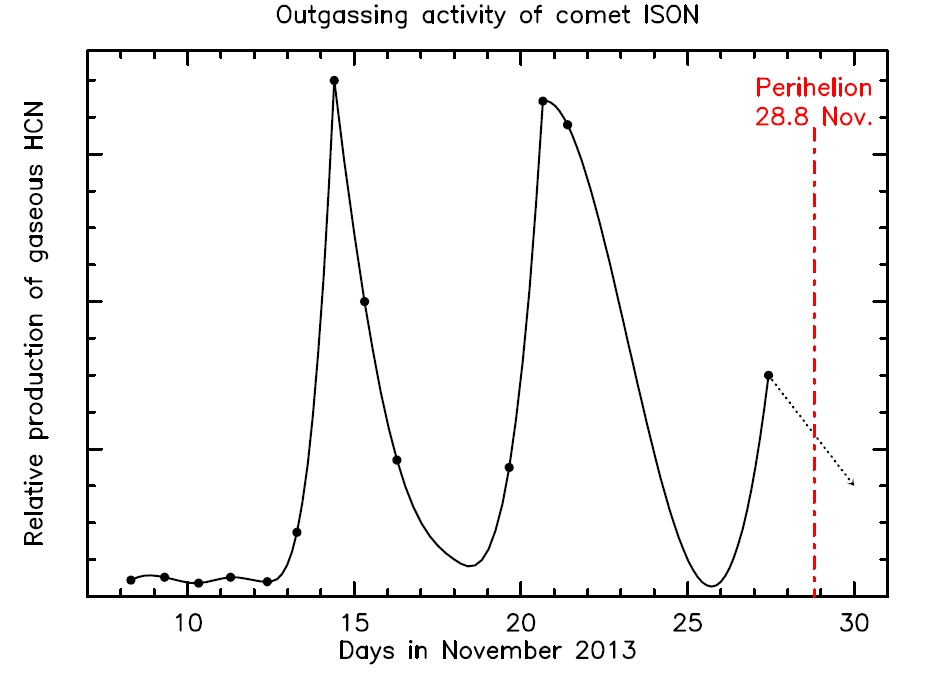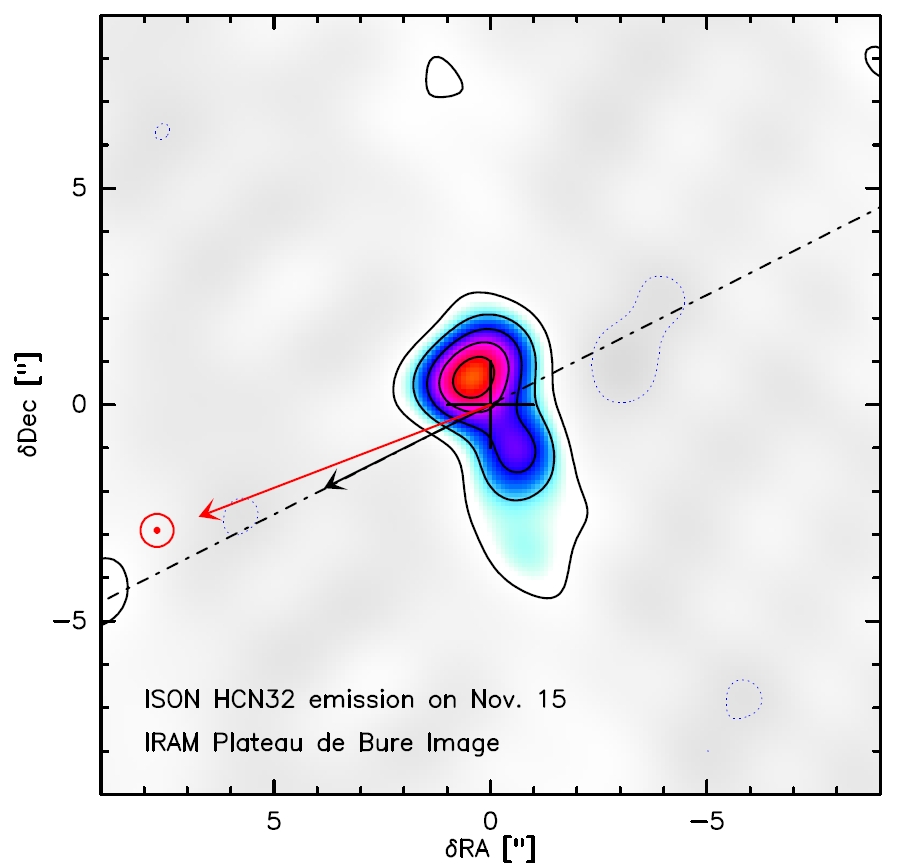News
IRAM telescopes look after comet ISON during its journey around the Sun
While the scientific world held its breath in the final days before the perihelion passage of comet ISON, several astronomer teams made extensive use of IRAM telescopes to follow the event. This was a unique opportunity to investigate the composition of a remnant of the formation of the solar system that would be exposed to very high temperatures, up to 2500 degrees at perihelion. As a researcher would do it in a laboratory, nature offered us the opportunity to progressively heat up some pristine solar system material and let us observe what comes out.
 |
| Fig.1: Evolution of ISON activity (gas release from the nucleus) during its approach to the Sun. |
IRAM made a significant effort to allocate time to several different programs in order to continuously follow the evolution of the comet as it approached and reached perihelion on November 28. The monitoring performed with the IRAM 30 meter telescope at Pico Veleta (Sierra Nevada, Spain) revealed a rough journey, alternating quiet periods and strong outbursts (Figure 1). These observations enabled the analysis of the composition of the material progressively released as the comet got heated up by the Sun. Several molecules were detected in comet ISON, such as the weakly emitting hydrogen isocyanide (HNC), methanol (CH3OH), and formyl cation (HCO+), in addition to the brightest HCN.
In the framework of the 30 meter observations of ISON, Nicolas Biver (LESIA, Paris Observatory, France) and Marcelino Agundez (Laboratoire d'Astrophysique de Bordeaux, France) were the first to report the major outburst of the comet on November 14-15. This outburst occurred only one day before ISON got too close to the Sun to be observed with the IRAM interferometer antennas at the Plateau de Bure (located in the French Alps), producing images revealing the distribution of gas around the nucleus. Jérémie Boissier (astronomer at IRAM) took this unique and tight opportunity to get an image of the comet during the outburst, showing a southwards jet of gas (Figure 2).
The end of its journey towards the Sun was followed again with the 30 meter telescope which witnessed the end of life of comet ISON. "Our jaws literally dropped when we saw the molecular emission lines dramatically fading between 21 and 25 November," said lead investigator Michal Drahus of the California Institute of Technology and the National Radio Astronomy Observatory (United States). "If the comet behaved normally, the line brightness - controlled by several physical processes - would remain basically constant. Instead, by the end of our observing time, the brightest emission line from hydrogen cyanide (HCN) was at least twenty times weaker than at the beginning." Such a rapid decline suggests that the comet's nucleus practically stopped replenishing the surrounding atmosphere with the molecular gas, or in other words - became defunct. While some persisting, weak sublimation could not be ruled out, it would certainly have to be below the level expected from a typical kilometer-size nucleus this close to the Sun.
 |
| Fig. 2: Image of the comet (emission from HCN molecules around the nucleus) during 15 November outburst. The black arrow indicates ISON's course towards the Sun (which direction is showed in red). |
The sudden disappearance of the molecular signatures did not stop comet ISON from putting on a great show during the perihelion passage in the evening of 28 November. Astronomers around the world were thrilled to watch the comet on the images from the Solar and Heliospheric Observatory. After the initial brightening, the object started to fade and seemingly dissipate in the final hours before perihelion, but managed to regenerate to some extent and reappeared on the other side of the Sun. "In the context of our earlier IRAM observations, it seems not unlikely that all that show was in fact generated by a dust cloud devoid of a sizable, active nucleus," Drahus speculates. "But this issue is certainly open, and final conclusions will have to await detailed analysis."
The researchers emphasize that their successful observations are only possible thanks to several unique features of the IRAM telescopes. "Unlike the classical optical telescopes, IRAM operates at millimeter and sub-millimeter wavelengths, unperturbed by sunlight," Drahus explained. "This makes the telescope a fantastic tool for the investigations of comets near the Sun, such as ISON. The 30m telescope is not only one of the largest telescopes designed for astronomical observations in the millimeter wavelength regime, but it is also equipped with some of the most technically advanced detectors. "We used the fast Fourier-transform spectrometers connected to the eight-mixer EMIR receiver, which together provide an unparalleled sensitivity and allow us to observe simultaneously many emission lines in a wide range of the comet's spectrum," said Israel Hermelo, astronomer at IRAM.
Contact:
Nicolas Biver - LESIA Observatoire de Paris
Marcelino Agundez – LAB Université de Bordeaux
Jérémie Boissier – IRAM
Michal Drahus - Caltech / NRAO (USA)



